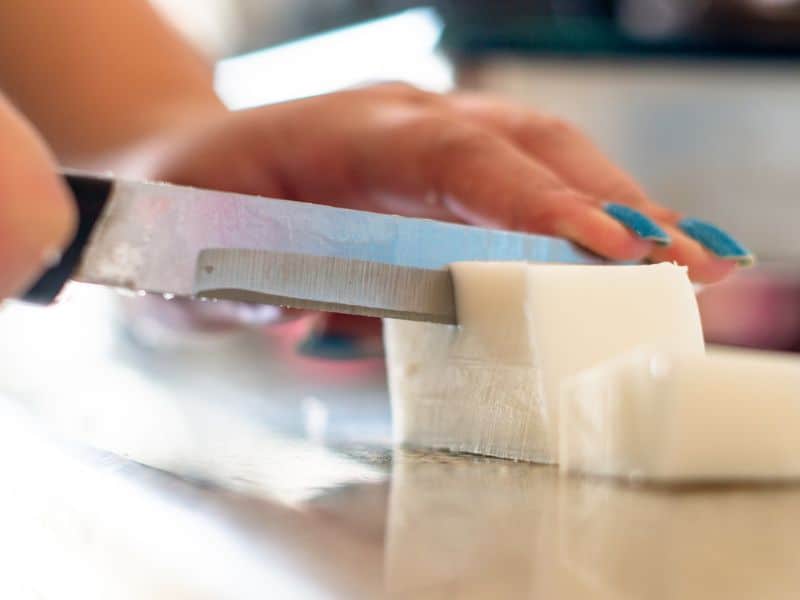Cold-processed soaps are made with natural ingredients and no harsh chemicals or preservatives. Making them an ideal choice for those looking for a more environmentally-friendly alternative to commercial products. But the benefits of cold process soap go even further than just being eco-friendly. In this article, we’ll explore those benefits and some of the other wonderful advantages that come along with making and using cold process soap.
Cold process soap has benefits such as it is gentle on the skin, nourishing and moisturizing, it’s made with natural ingredients, eco-friendly, versatile, and customizable. It is a fantastic option for those looking for a natural and nourishing soap.
You will find that cold process soap is a lot easier on the skin than some of the store-bought “soaps” that are full of synthetic ingredients and chemicals. Let’s look at some more benefits of cold process soap.
Benefits of Cold Process Soap
Here are some of the benefits of cold process soap and some of the reasons why it is becoming increasingly popular among soap makers and consumers.
Gentle on the skin
Cold process soap is gentle on the skin because it is made with natural ingredients and does not contain harsh chemicals found in commercial soaps. The process of making cold process soap preserves the natural glycerin, which is a natural moisturizer that helps to keep the skin hydrated and healthy.
Cold process soap also has a lower pH level, making it less harsh on the skin than other types of soap.
Nourishing and moisturizing
The oils used in cold process soap, such as coconut oil, olive oil, and shea butter, are rich in nutrients that nourish and moisturize the skin. These oils are high in essential fatty acids, vitamins, and minerals that help to restore and maintain the skin’s natural moisture balance.
Cold process soap is also beneficial for those with dry or sensitive skin, as it helps to soothe and calm irritated skin.
Natural ingredients
Cold process soap is made with natural ingredients, making it an excellent choice for those who prefer to use products that are free from harsh chemicals and synthetic fragrances.
The oils, herbs, and essential oils used in cold process soap are carefully selected for their skin-nourishing properties and are free from harmful additives and preservatives.
Eco-friendly
Cold process soap is an eco-friendly choice because it is made with natural, sustainable ingredients and does not require a lot of energy to produce. The packaging for cold process soap is often minimal and can be made from recyclable or biodegradable materials.
Because cold process soap is long-lasting and does not contain synthetic additives, it is a more environmentally friendly choice than commercial soaps.
Versatile and customizable
One of the benefits of cold process soap is its versatility and customizability. The oils, herbs, and essential oils used in cold process soap can be combined in endless variations to create unique scents and properties.
This allows individuals to create custom soaps that are tailored to their specific skin type and preferences.
Common Misconceptions About Cold Process Soap
There are some misconceptions about this cold process soap making method that may prevent individuals from trying it out. Let’s debunk some of the them now.
Myth: Cold Process Soap is Too Harsh For Sensitive Skin
One of the most common misconceptions about cold process soap is that it is too harsh for sensitive skin. This is not entirely true. While it is true that some soaps made with harsh ingredients can irritate sensitive skin, cold process soap made with natural ingredients is gentle on the skin.
In fact, cold process soap is often recommended for those with sensitive skin, as it is free from harsh chemicals found in commercial soaps.
Myth: Cold Process Soap is Difficult To Make
Another misconception about cold process soap is that it is difficult to make. While cold process soap requires some knowledge and practice, it is not as difficult as some may think. With the right ingredients and equipment, anyone can make cold process soap at home.
There are numerous online resources and tutorials available to guide individuals through the soap making process. Additionally, once the soap making process is mastered, it can be a fun and rewarding hobby.
Myth: Cold Process Soap is More Expensive Than Commercial Soap
Some people may avoid cold process soap because they believe it is more expensive than commercial soap. However, this is not necessarily true. While cold process soap may have a higher upfront cost due to the use of natural ingredients and equipment, it is often more cost-effective in the long run. Cold process soap is long-lasting, meaning it lasts longer than commercial soap.
Additionally, because cold process soap is customizable, individuals can tailor their soap to their specific needs, eliminating the need for additional skincare products.
Cold Process Soap Making Explained
Explanation of Cold Process Soap Making
Cold process soap is a method of soap making that involves mixing oils, water, and lye to create a chemical reaction that results in the formation of soap. The term “cold process” refers to the fact that no external heat source is used to facilitate the saponification process. Instead, the mixture is left to sit and cure for several weeks until it becomes solid soap.
The process begins by measuring out the oils and heating them up to their melting point. Next, lye is added to water to create a lye solution. The lye solution is then slowly added to the melted oils, and the mixture is stirred until it reaches trace – the point at which the mixture thickens and leaves a trail when stirred.
Once the mixture has reached trace, any additives such as fragrance oils, essential oils, or herbs can be added. The mixture is then poured into a mold and left to sit for several weeks until it hardens into soap.
How it Differs From Other Soap Making Methods
One of the primary differences between cold process soap and other soap making methods is the absence of external heat. Hot process soap, for example, involves heating the soap mixture to speed up the saponification process. Melt and pour soap involves melting pre-made soap bases and adding additives to create custom soaps.
Another significant difference is the curing time required for cold process soap. Unlike hot process soap, which can be used immediately after it is made, cold process soap needs to sit and cure for several weeks before it can be used. This curing time allows the soap to harden and ensures that any excess water evaporates, resulting in a longer-lasting bar of soap.
Ingredients Used in Cold Process Soap
Cold process soap typically uses a combination of oils, water, and lye. The oils used can vary depending on personal preference and the desired properties of the soap. Popular oils include coconut oil, olive oil, palm oil, and castor oil.
Lye, also known as sodium hydroxide, is a caustic substance that is necessary for saponification to occur. While lye can be dangerous if mishandled, it is a necessary component of soap making and is used in the correct proportions to ensure that it is fully saponified by the end of the curing process.
In addition to oils and lye, cold process soap can also contain additives such as fragrance oils, essential oils, herbs, and natural colorants. These additives can be used to create custom soaps with specific scents, colors, and properties.
How to Use and Store Cold Process Soap
Cold process soap is wonderful, but it is important to know how to use and store it properly to get the most out of its benefits.
Tips for using cold process soap
- Wet your hands and the soap: Before using cold process soap, wet your hands and the soap. This will help to create a lather and make the soap easier to use.
- Avoid using too much: Cold process soap is highly concentrated and a little goes a long way. Use only a small amount of soap to avoid stripping the skin of its natural oils.
- Rinse thoroughly: After using cold process soap, rinse your skin thoroughly with warm water to remove any residual soap.
- Follow up with moisturizer: While cold process soap is nourishing for the skin, it is still important to follow up with a moisturizer to lock in hydration.
Proper storage methods to prolong shelf life
- Keep it dry: Cold process soap should be kept in a dry area to avoid the growth of mold or bacteria. After use, place the soap in a well-ventilated area to dry out.
- Avoid direct sunlight: Direct sunlight can cause the soap to melt or fade, so it is best to store cold process soap in a cool, dry place away from sunlight.
- Use a soap dish: A soap dish can help to prolong the life of cold process soap by allowing excess water to drain away from the soap.
- Store in an airtight container: If you plan to store cold process soap for an extended period, consider storing it in an airtight container to prevent exposure to air and moisture.
Frequently Asked Questions
You will need a digital scale, mixing bowls, a stick blender, a soap mold, and safety gear such as gloves and goggles.
The basic ingredients for cold process soap making are oils, lye, and water. Other ingredients such as fragrances and colors can be added as well.
When making cold process soap, it is important to wear gloves and goggles to protect yourself from the lye. Additionally, make sure to work in a well-ventilated area and follow proper storage and handling of the ingredients.
Common mistakes include not measuring ingredients properly, not mixing the ingredients thoroughly, and not properly calculating the lye amount.
Cold process soap takes around 4-6 weeks to cure before it is ready for use.
Yes, fragrances and colors can be added to cold process soap, but it is important to use skin-safe and natural ingredients.
No, lye is a necessary ingredient in cold process soap making as it is needed to create the saponification reaction that turns oils and water into soap.
Conclusion
In conclusion, cold process soap making is a wonderful way to create your own custom soaps and it has many benefits. It involves carefully measuring and combining oils, lye, and water and then curing the soap for 4-6 weeks. When using cold process soap, it is important to take proper safety precautions when working with lye as well as wetting your hands and the soap before use.
Additionally, be sure to store the soap properly in a dry area away from direct sunlight in order to prolong its shelf life. With all of these tips in mind, you can enjoy the benefits of homemade cold process soap!






